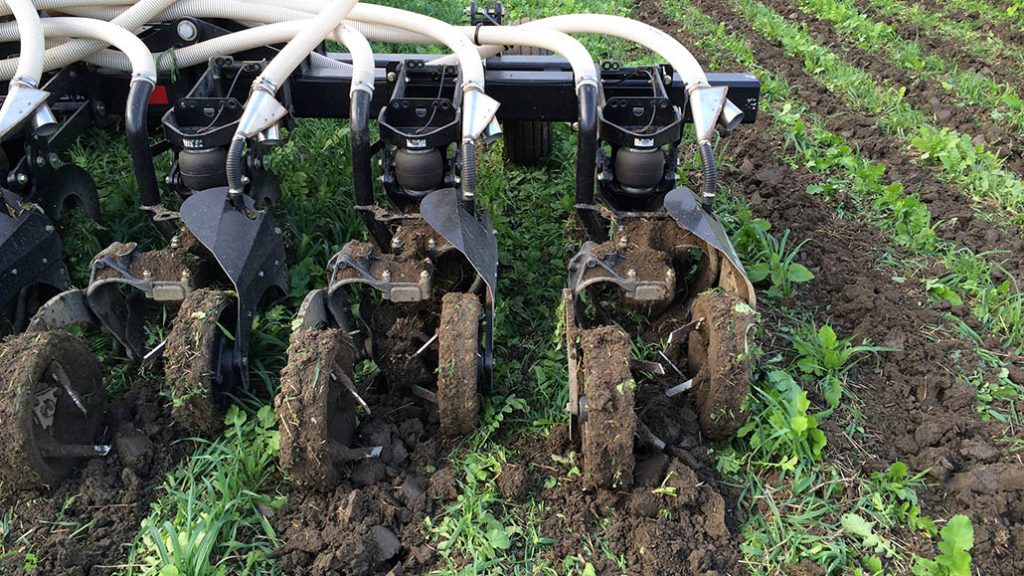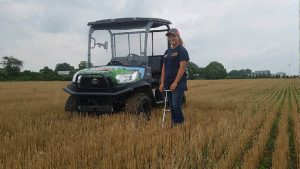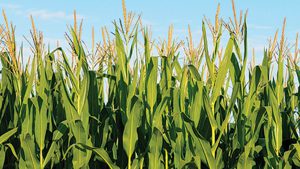Making fertilizer work in strip-till
A PROFILE OF TWO RESEARCH PROJECTS

AS MORE FARMERS investigate the potential of strip-tillage, and as nutrient runoff issues continue to be a major environmental concern, more effort is being invested in understanding nutrient management between conventional and no-till systems.
Since 2016, Grain Farmers of Ontario has funded two research projects focused on this area of strip-till agronomy — that is, the potential economic and environmental successes of different approaches to nutrient management.
With one project completed and the other beginning, conclusions and further expectations continue to evolve.
REDUCING RISK
In the 2016-2017 crop year, Aaron Breimer, general manager for Chatham-based Veritas Farm Management, headed a project analyzing strip-till strategies producers could use to mitigate off-target phosphorus movement — while maintaining or increasing productivity and profitability. That included looking for both yield increases, and the potential to reduce fertilizer applications through better placement.
How it worked:
Tillage test plots were divided into zones of expected yield, with fertilizer variably applied based on the yield potential of each zone. Plant tissue samples were taken to see how much phosphorus was being absorbed by the crops, while samples of crop residue and the soil itself revealed how much of the nutrient was water extractable (a runoff risk).
“We don’t believe a field is uniform from one end to the other. There’s variability. We also believe there’s variability in soil texture levels as you go across the field,” says Breimer. “What we were doing is going back and sampling the same area time and time again.”
Yield and yield related data were also kept.
What they found:
Breimer says no positive or negative differences in crop productivity were observed between strip tillage and other approaches (minimum-till and no-till). Regarding the potential for applying less phosphorus per acre, he says their data indicated farmers working with very fertile conditions might be able to successfully lower input amounts without corresponding yield losses.
However, Breimer also says the research team did not find an economic or agronomic justification to do so. Even if some areas are fertile, he says, the fertilizer savings there could be transferred to lower-fertility areas.
“Traditionally the thinking is if you have phosphorus levels above 35 parts per million, you probably don’t need to apply a lot. But if you talk to a farmer or a certified agronomist, they might say you need a little,” he says.
The data also showed crops planted into strip-till rows did absorb phosphorus at a higher rate early in the season – but that gain didn’t last.
“By the time we got to maturity the levels had basically leveled themselves out. Strip-till seemed to give it a little extra kick in the spring,” says Breimer.
Additionally, increases in water-soluble phosphorus in soil and crop residues were only significant in plots with very high phosphorous levels. Even in plots with very low levels of available phosphorus — the only places where sulphur deficiencies also appeared to be an issue — no system indicated statistically different crop residue levels.
“Each site was so unique […] The biggest difference was not between different treatments but between different sites,” says Breimer. He adds useful insights into each test area were found, but those insights became lost once all test data was compiled in aggregate.
While he says more research sites and seasons are needed to draw concrete conclusions, Breimer believes strip-tillage is a good compromise between conventional and no-till systems. He adds, however, that basic agronomy practices need to be followed in all systems.
“We need to do a better job of soil sampling in Ontario,” he says. “It’s hard to make recommendations without good soil test data.” (see ‘Soil sampling’ on page 18.)
ANALYZING TIMING AND PLACEMENT
A more recent initiative focuses on fertilizer timing and placement strategies. The goal, says Ben Rosser, corn specialist for the Ontario Ministry of Agriculture, Food and Rural Affairs — and the head researcher behind the project — is to determine the efficiency of that placement, as well as fall and spring applications.
How it will work:
This project, which was launched in the spring of 2018 and will conclude after the 2021 growing season, will feature four to five trials each year in Perth, Wellington, Brant, and Oxford counties. These trials will be conducted with co-operators that currently employ conventional tillage systems.
In order to better highlight fertilizer response potential, plots will also be placed on locations with low phosphorus and potassium fertility. A variety of tillage and fertilizer placements methods will be analyzed. This includes measuring phosphorus loss in strip till systems where nutrients are incorporated, and comparing it to broadcast application in conventional tillage.
Project Expectations:
Rosser says the project is expected to yield results that will translate to practical fertilizer application strategies for farmers getting into — or already using — strip-tillage. Data from the project’s first year is now being compiled, though Rosser stresses it is too early to draw any major conclusions. This is particularly true given the first fall fertilizer applications were just performed this past autumn.
“Certainly, the better your ability to get phosphorus below the ground the more likely you are to not loose it off the surface,” he says.
Additional information and interim results from Rosser’s project, officially titled ‘Evaluating Strip Tillage and Fertility Placement to Reduce Soil and P Loss’, will be posted on the Grain Farmers of Ontario research database at www.gfo.ca as they become available.
Rosser’s project is funded in part through the Canadian Agricultural Partnership (the Partnership), a federal-provincial-territorial initiative. The Agricultural Adaptation Council assists in the delivery of the Partnership in Ontario. •






















